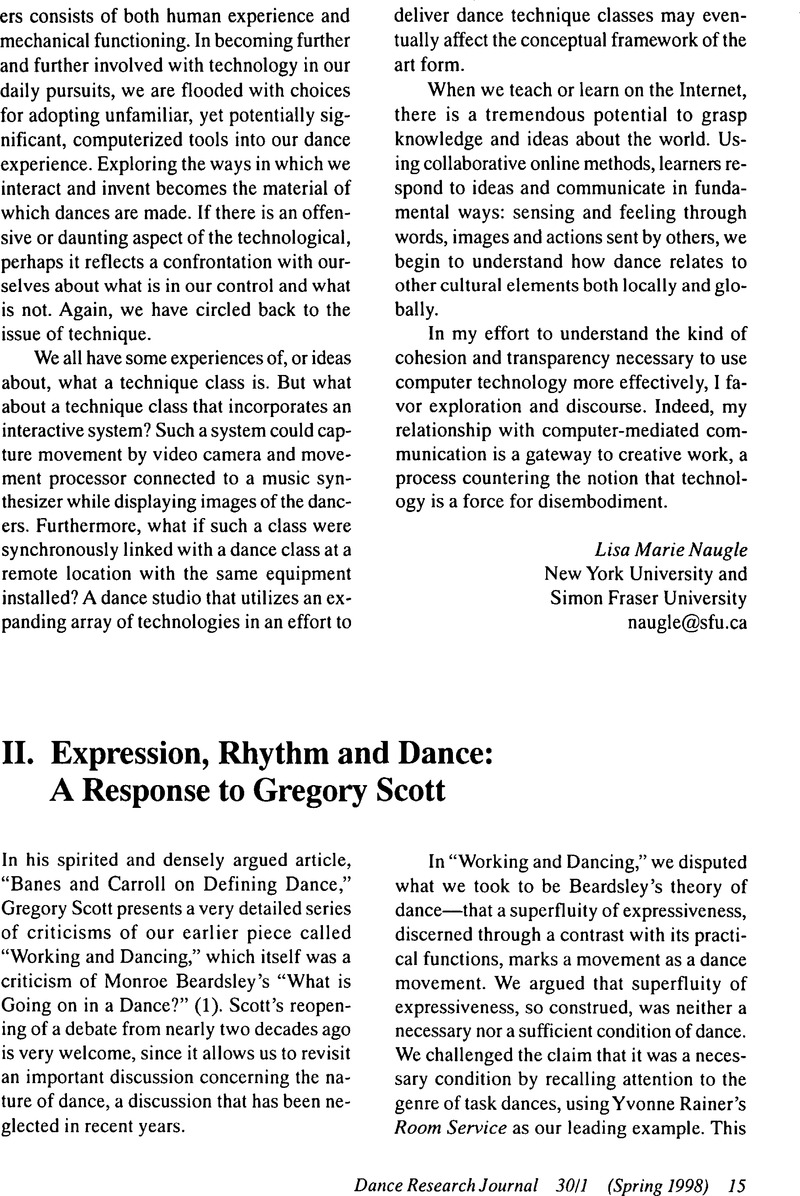Article contents
II. Expression, Rhythm and Dance: A Response to Gregory Scott
Published online by Cambridge University Press: 22 July 2014
Abstract

- Type
- Dialogues
- Information
- Copyright
- Copyright © Congress on Research in Dance 1998
References
NOTES
1. See: Scott, Gregory, “Banes and Carroll on Defining Dance,” Dance Research Journal 29/1 (1997): 7–22CrossRefGoogle Scholar (hereafter cited parenthetically in the text); Carroll, Noël and Banes, Sally, “Working and Dancing: A Response to Monroe Beardsley's ‘What is Going on in a Dance?’” Dance Research Journal 15/1 (1982): 37–42CrossRefGoogle Scholar; Beardsley, Monroe, “What is Going on in a Dance?” Dance Research Journal 15/1 (1982): 31–37.CrossRefGoogle Scholar The Beardsley article and the article by Carroll, and Banes, have been reprinted in Aesthetics: A Critical Anthology, ed. Dickie, George, Sclafani, Richard, and Roblin, Ronald, 2nd ed. (New York: St. Martin's Press, 1989), 635–650.Google Scholar References to these articles cited parenthetically in the text refer to the pagination in Aesthetics: A Critical Anthology.
2. However, it should be pointed out that one way of reading the concluding sentence of Beardsley's essay is to understand it as providing only a sufficient condition for dance. That is, once pared down, the sentence appears to say “If x possesses a superfluity of expressiveness, then x is a dance movement.” But if Beardsley is really only advancing a sufficient condition for dance, and Scott thinks that we've blocked that, then, as they say, the jig is up (perhaps before it begins).
3. Of course, whether one thinks that these two dances substitute flow or pictorialism for rhythm depends on how one defines rhythm in dance, which so far Scott has not indicated. Moreover, if Scott does define rhythm, he must be careful not to define it too broadly, lest all movement fall into the category of dance.
4. Rambert, Marie, Quicksilver (London: Macmillan, 1972), 62.Google Scholar
5. Danto, Arthur, The Transfiguration of the Commonplace (Cambridge, MA: Harvard University Press, 1981).Google Scholar
6. Similarly, in a later part of the article, Scott tries to imagine an artistic tradition for Van Gogh's mutilation of his own ear. But unless Van Gogh was working within the conceptual frameworks of these traditions in such a way that they had actual, material influence on what he did, we would not be willing to grant that he was working in the relevant traditions.
7. This is explained at greater length in Carroll, Noël, “Historical Narratives and the Philosophy of Art,” Journal of Aesthetics and Art Criticism 51/3 (1993): 313–326.CrossRefGoogle Scholar
8. For detailed exposition of our view of this kind of narrative, see: Noël Carroll, “Historical Narratives and the Philosophy of Art,” and Carroll, Noël, “Identifying Art,” in Institutions of Art, ed. Yanal, Robert (University Park, PA: Penn State University Press, 1993), 3–38.Google Scholar
9. Moreover, this is not simply a matter of taking Rainer's pronouncements about what she's done at face value. That Rainer said so would not be enough to count Room Service as dance. Rather, we would want to ask whether what she said struck us as reasonable within the artworld and danceworld contexts in which she operated, given her beliefs and motives, supposing them to be informed and situationally intelligible. The choreographer cannot make her work dance by fiat. On the other hand, we need not ignore what the choreographer says, since it may give us insight into her beliefs, desires, and intentions where those factors, among others, are relevant to determining which action the agent performed. That is, what Rainer thought she was doing, rather than what she might merely say she was doing, is what is important, where her thinking can also be shown to be embedded, well-motivated, and shaped by an intelligible danceworld problematic.
10. On page 17, Scott indicates that he is skeptical about our faith in narration as crucial to classification. He signals a preference for definitions in terms of necessary and sufficient conditions. He claims that the necessary-and-sufficient-condition approach is the tested one, while the narrational approach is not. Perhaps a few comments are worth making here. First, though we have no objection to the use of this sort of analysis in some cases, it is not clear that it is the only option in all cases. For example, consider the causal theory of meaning in philosophy and prototype theory in psychology. Moreover, for some purposes, the method is not so much tested as contested. In biology, for instance, cladistic speciation is determined by narratives of descent, not by necessary and sufficient conditions. Similarly, on our view, narration may be a superior method for classifying dance than definitions employing necessary and sufficient conditions which, when stated, as in the Scott-Beardsley theory, in terms of perceptual properties like expression and rhythm, may close the concept in a way that is ultimately question-begging.
11. We would like to thank Joan Acocella and Jim Sutton for their help in writing this article.
- 2
- Cited by


